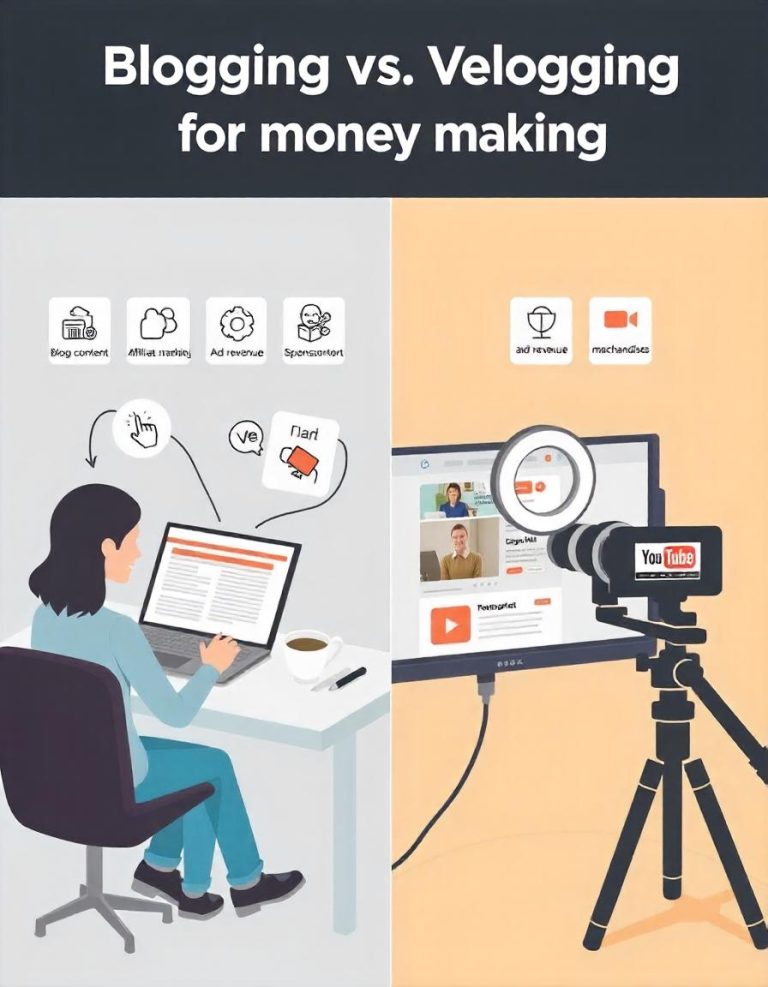The Ultimate Blogging Guide: From Idea To Successful Blog
Blogging is a powerful tool for sharing your ideas, promoting a business, or building an online community. Whether you’re looking to start a personal blog, create content for a brand, or establish yourself as an authority in a specific field, this guide will walk you through the essential steps to help you succeed.
Find Out How To Make Money As A Full-Time Writer/Blogger Guide
1. Choosing Your Blog Topic
One of the most important steps in starting a blog is choosing a topic that excites you and resonates with your audience. Here’s how to decide on a niche:
- Passion and Expertise: Choose something you’re passionate about and knowledgeable in. It could be travel, technology, fitness, food, lifestyle, or anything else that you enjoy writing about.
- Audience Demand: Research what people are searching for and identify gaps in the content. Use tools like Google Trends or Answer the Public to find popular topics.
- Longevity: Make sure your blog topic has long-term potential. You want to pick something that can sustain your interest and content creation over time.
2. Setting Up Your Blog
Once you’ve decided on a topic, it’s time to set up your blog. Here’s how to get started:
a. Choose a Blogging Platform
There are many blogging platforms available. Here are the most popular options:
- WordPress: Ideal for those who want full control and scalability. It offers a wide range of customization options and plugins.
- Blogger: A free and simple platform owned by Google, perfect for beginners.
- Medium: A minimalistic platform where you can focus entirely on writing. It’s great for those who don’t want to worry about design.
- Squarespace or Wix: Both offer easy-to-use drag-and-drop website builders and are perfect for visually-focused blogs.
Find Out How To Make Money As A Full-Time Writer/Blogger Guide
b. Get a Domain Name
Your domain name is your online identity. Choose a name that is short, memorable, and relevant to your blog. Sites like Namecheap or GoDaddy allow you to purchase domain names.
c. Select Web Hosting
If you’re using WordPress, you’ll need web hosting. Popular providers like Bluehost, SiteGround, or HostGator offer hosting services optimized for WordPress. This is where your blog will be stored.
d. Design Your Blog
- Choose a theme that matches the aesthetic of your blog.
- Customize the theme to suit your branding (colors, fonts, logos, etc.).
- Make sure the design is clean, simple, and user-friendly for a great user experience.
3. Creating Quality Content
Now that your blog is set up, it’s time to start writing! Here are tips for creating high-quality blog content:
Find Out How To Make Money As A Full-Time Writer/Blogger Guide
a. Understand Your Audience
Before writing, understand who your target audience is and what they want to read. Create content that addresses their pain points, needs, and interests. Write in a way that resonates with them.
b. Craft Compelling Titles
Your title is the first thing readers will see, so it’s crucial to make it compelling. Use power words and be clear about the value the post will offer. Examples include “How to,” “Why you should,” or “The Ultimate Guide to.”
c. Write Engaging and Informative Posts
When writing your posts, aim to:
- Solve Problems: Offer practical solutions or advice.
- Tell Stories: Personal anecdotes and stories engage readers and make your blog more relatable.
- Be Clear and Concise: Avoid fluff and keep your writing focused.
- Add Value: Your content should help readers in some way—whether through education, entertainment, or inspiration.
d. Use Visuals
Incorporate images, infographics, and videos into your posts to break up text and make your content more engaging. Tools like Canva can help you create stunning visuals.
e. Optimize for SEO
To make your blog posts discoverable on search engines, optimize them for SEO (Search Engine Optimization):
- Use Keywords: Research keywords related to your topic and incorporate them naturally into your posts.
- Optimize Meta Descriptions: Write a compelling meta description for each post.
- Include Alt Text for Images: This helps search engines understand what the image is about.
Find Out How To Make Money As A Full-Time Writer/Blogger Guide
4. Promoting Your Blog
Once you’ve started writing and publishing posts, it’s time to drive traffic to your blog. Here’s how to promote your content:
a. Share on Social Media
- Share your posts on platforms like Facebook, Twitter, Instagram, and LinkedIn to reach a wider audience.
- Use relevant hashtags to increase visibility.
- Engage with your followers and encourage them to share your content.
b. Email Marketing
Build an email list by offering incentives (like free eBooks, guides, or discounts) in exchange for readers’ email addresses. Send regular newsletters with links to your latest blog posts to keep your audience engaged.
c. Collaborate with Other Bloggers
Guest post on other blogs, collaborate with influencers, or participate in round-up articles. This exposes your blog to new audiences and helps you build backlinks for SEO.
d. Comment on Other Blogs
Engage with other blogs in your niche by leaving thoughtful comments. This helps you build relationships with fellow bloggers and drive traffic to your own site.
e. Use Paid Advertising
If you have a budget, consider using paid ads on social media or Google to promote your posts to a targeted audience.
Find Out How To Make Money As A Full-Time Writer/Blogger Guide
5. Monetizing Your Blog
Once your blog gains traffic, you can start earning money through various monetization methods:
a. Affiliate Marketing
Promote products or services and earn a commission for every sale made through your referral link. Join affiliate programs like Amazon Associates, ShareASale, or Rakuten.
b. Sponsored Posts
Work with brands to write sponsored content that aligns with your audience. Brands pay you to publish content about their products or services.
c. Sell Your Products or Services
If you have your own products, courses, or services, your blog can serve as a platform to sell them. Set up an online store or offer consulting services to your audience.
d. Display Ads
Google AdSense and other ad networks allow you to display ads on your blog and earn revenue based on clicks or impressions.
6. Analyzing Your Blog’s Performance
To track your blog’s growth and performance, use analytics tools like Google Analytics. This will help you monitor:
- Traffic Sources: Understand where your visitors are coming from (social media, search engines, etc.).
- User Behavior: Track how long users stay on your site and which pages are the most popular.
- Conversion Rates: Measure how well your calls-to-action (like signing up for a newsletter) are performing.
By consistently analyzing your blog’s performance, you can identify areas for improvement and optimize your content strategy.
Find Out How To Make Money As A Full-Time Writer/Blogger Guide
7. Staying Consistent and Improving
Blogging is a long-term commitment. To succeed, you need to consistently publish high-quality content, engage with your audience, and refine your strategy based on feedback and analytics.
- Create a Content Calendar: Plan your blog posts in advance to stay consistent.
- Keep Learning: Blogging trends and SEO practices evolve, so continue to learn and stay updated with the latest techniques.
Find Out How To Make Money As A Full-Time Writer/Blogger Guide
Starting a blog can be an exciting and rewarding venture. By choosing the right niche, setting up your blog correctly, producing quality content, and promoting it effectively, you’ll be well on your way to blogging success. Remember, blogging requires patience and persistence, but with dedication, you can grow a loyal audience and even monetize your blog over time.







